SSZTBH2 March 2016 SN74AUP1T34-Q1 , TXS0102-Q1
Jennifer Joseph
Automotive electronics and infotainment systems comprise a plethora of electronic components such as microcontrollers, sensors and other peripherals that operate at different voltages. Dropping microcontroller voltages in these electronics achieves higher power efficiencies, but peripherals still require operation at higher voltages. This creates a situation of voltage incompatibility that voltage level-shifters/translators can resolve. TI’s automotive portfolio includes voltage level-shifters/translators that are compliant with Automotive Electronics Council (AEC)-Q100.
Figure 1 illustrates incompatible logic threshold levels between 3.3V microcontrollers and legacy 5V peripherals. To interface at least two devices successfully, requires these conditions:
- The output high voltage (VOH) of the driver must be greater than the input high voltage (VIH) of the receiver.
- The output low voltage (VOL) of the driver must be less than the input low voltage (VIL) of the receiver.
- The output voltage from the driver must not exceed the input/output (I/O) voltage tolerance of the receiver.
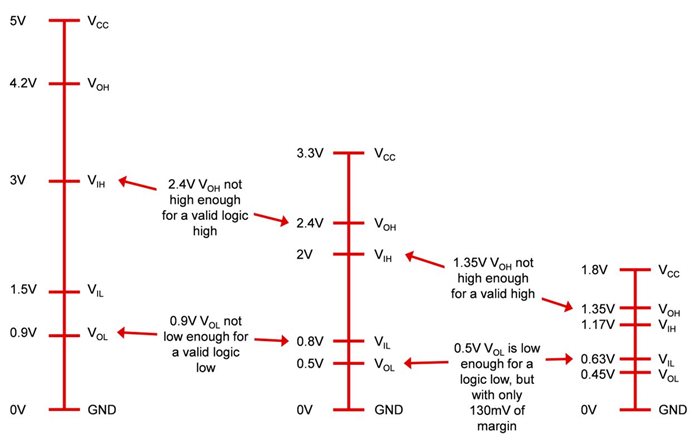 Figure 1 Illustrating Logic-level
Incompatibility
Figure 1 Illustrating Logic-level
IncompatibilityIn complex infotainment systems, unidirectional voltage-level translators such as the SN74AUP1T34-Q1, allows interfacing from extremely low-voltage processors to 3.3V peripherals. It also provides enough output drive current to fan out to multiple loads. Figure 2 shows an application use case of the SN74AUP1T34-Q1 as a clock fanout buffer. Figure 3 shows the SN74AUP1T34-Q1 measurement data of low jitter (~ 500ps).
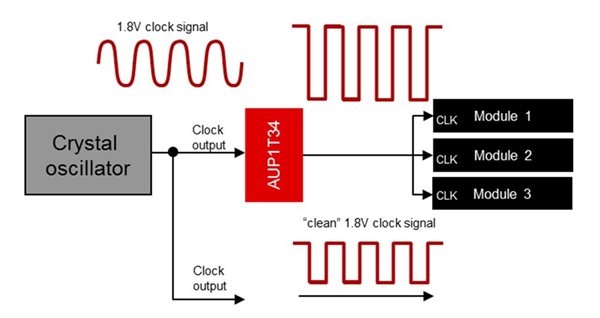 Figure 2 The SN74AUP1T34-Q1 as a Clock
Fanout Buffer
Figure 2 The SN74AUP1T34-Q1 as a Clock
Fanout Buffer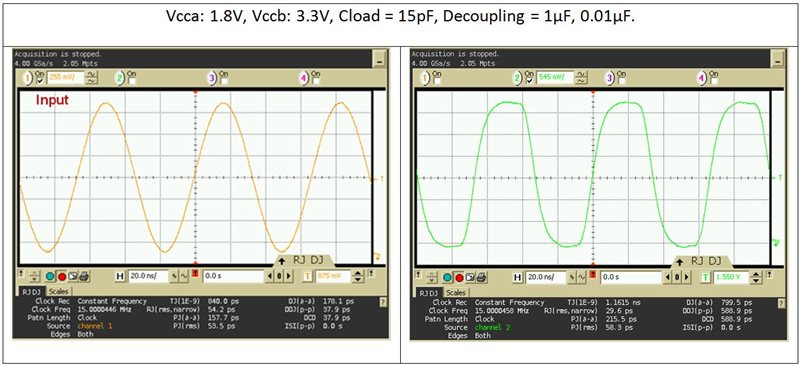 Figure 3 SN74AUP1T34-Q1 Buffers Sine
Input to a Square-wave Output
Figure 3 SN74AUP1T34-Q1 Buffers Sine
Input to a Square-wave OutputIf you do not want to configure the direction of the level shifter, you can use autodirection translators such as the TXS0102-Q1, TXS0104-Q1 and TXB0102-Q1. The TXS0102-Q1 has low leakage and static consumption and saves precious power for other critical devices during start/stop events. Figure 4 shows an application use case of the TXS0102-Q1 for an open-drain signal interface. Figure 5 shows the TXS0102-Q1 measurement data when used as an I2C level shifter.
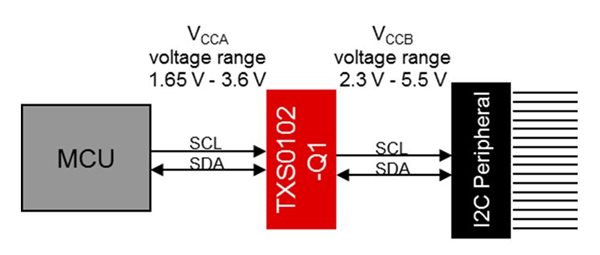 Figure 4 The TXS0102-Q1 as an
Open-drain Level Shifter
Figure 4 The TXS0102-Q1 as an
Open-drain Level Shifter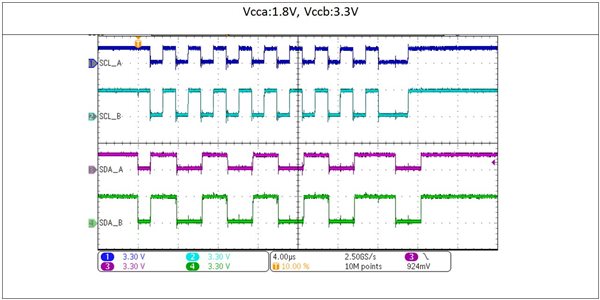 Figure 5 The TXS0102-Q1 I2C
Level Shifter for Clock and Data
Figure 5 The TXS0102-Q1 I2C
Level Shifter for Clock and DataIf you want to control the direction of the level shifter, consider translators such as the SN74LVCxT245-Q1 and SN74AVCxT245-Q1 family for heavily loaded buses where multiple devices are connected to the bus. These devices offer up to 12mA/24mA of current, respectively, and a dedicated DIR pin controls the flow of data.
Since microcontrollers (MCUs) and microprocessors (MPUs) are migrating to more advanced processors with higher processing power for image recognition and greater resolution, cost and power savings are driving the need for lower-voltage operation in infotainment, advanced driver assistance systems (ADAS), telematics and cluster systems. This introduces a need for voltage-level translation that is readily achievable with TI’s portfolio of AEC-Q100-compliant voltage level-shifters/translators.
How are you using voltage level-shifters or translators in your automotive applications? Log in to post a comment below.
Additional Resources
- Learn more about voltage-level translation and the specific devices discussed in this post.
- Visit the TI E2E™ Community voltage translation forum to find questions and answers from TI’s logic and voltage translation team and fellow engineers.
- Read our blog post, “Good designs need the right translation.”